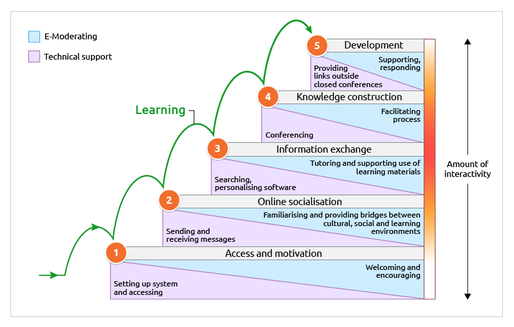This topic follows very nicely the previous one regarding its emphasis in the different presences: social presence, cognitive presence, and teaching presence. However this topic adds the emotional aspect of learning as a forth presence (Cleveland-Innes & Campbell, 2012)
It is very difficult to imagine people without their emotional aspect in their lives. So why would learning be different? The name of the game is engagement, it is after all a key player in the retention of students in higher education (van Ameijde, J., Weller, M. and Cross, S. (2018)) and can be directly correlated to higher marks (Vaughan, N. (2014)).
 Salmon, G (2013) The Five Stage Model.
Salmon, G (2013) The Five Stage Model.
For my previous post I mentioned that I realized the contents of ONL191 followed our own path in online learning. For me this was an immediate boost in my engagement and even lead the discussion for PBL11. It suddenly clicked more than before. I was at first thinking mainly what and how am I going to apply this to my lectures and nothing else. Then the Five Stage Model (see above) came and I couldn’t help but notice the similarities between ONL191 and the scaffold scheme in the model and how I was being part of it myself. Nice =D
Realizing that was very nice and I got some inspiration boost. I am quite unsure whether after this course I will be already at stage 4 or 5. I think soon I will have the opportunity to jump into the abyss of number 5 and with time feel more and more confident being a ‘digital resident‘ there. However in my own practice we are very unlikely to go for online learning so from this point on I will focus on blended learning as it will be the one relevant for me. But what exactly is blended learning?
[B]lended learning is a term applied to the practice of providing instruction and learning experiences through some combination of both face-to-face and technology-mediated learning. During the technology-mediated components of these learning experiences, students are not required to be physically together in one place but may be connected digitally through online communities.
So, as a final thought I would like to leave this video by Veritasium regarding viral videos and an interesting discussion regarding how videos go viral. It is not really 1-to-1 with teaching but for sure attention span, creative content, timely feedback and maybe this does not apply for blended learning but perhaps it is more relevant for fully online learning. Are we aiming to go viral with education?
But surely blended learning is not just adding some digital content to your lectures as many teachers did with tools like Live@Lund but it means an good integration between classical teaching aspects and digital aspects. I personally look forward to turn my newly assigned course into a blended experience. The Guide to blended learning is an excellent resource that I intent to go back to for the preparation of course.